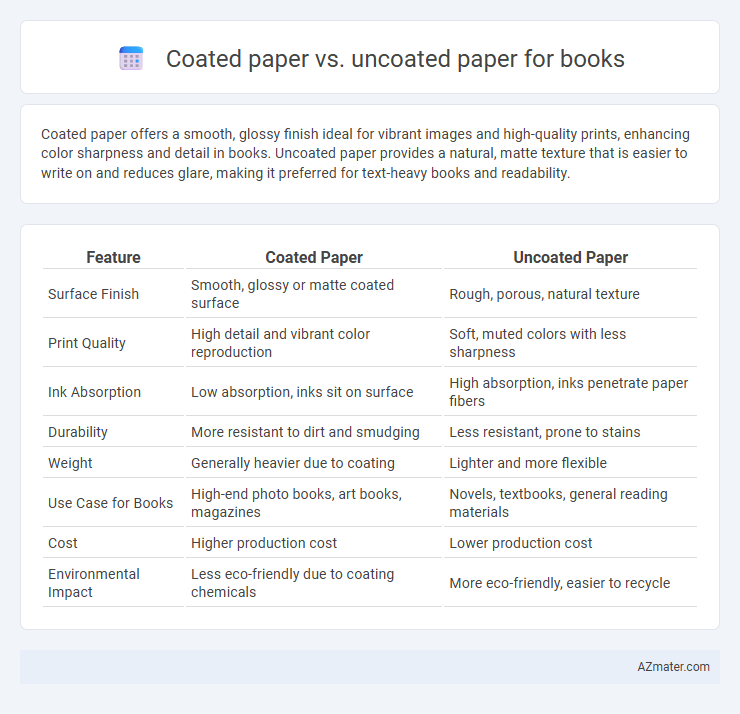Coated paper offers a smooth, glossy finish ideal for vibrant images and high-quality prints, enhancing color sharpness and detail in books. Uncoated paper provides a natural, matte texture that is easier to write on and reduces glare, making it preferred for text-heavy books and readability.
Table of Comparison
| Feature | Coated Paper | Uncoated Paper |
|---|---|---|
| Surface Finish | Smooth, glossy or matte coated surface | Rough, porous, natural texture |
| Print Quality | High detail and vibrant color reproduction | Soft, muted colors with less sharpness |
| Ink Absorption | Low absorption, inks sit on surface | High absorption, inks penetrate paper fibers |
| Durability | More resistant to dirt and smudging | Less resistant, prone to stains |
| Weight | Generally heavier due to coating | Lighter and more flexible |
| Use Case for Books | High-end photo books, art books, magazines | Novels, textbooks, general reading materials |
| Cost | Higher production cost | Lower production cost |
| Environmental Impact | Less eco-friendly due to coating chemicals | More eco-friendly, easier to recycle |
Introduction to Coated vs Uncoated Paper
Coated paper features a smooth, sealed surface achieved by applying a layer of clay or polymer, enhancing print quality with vibrant colors and sharp details ideal for high-quality images and graphics in books. Uncoated paper lacks this surface treatment, resulting in a porous texture that absorbs ink more readily, creating a natural, matte finish often preferred for text-heavy content or a tactile reading experience. The choice between coated and uncoated paper significantly impacts print appearance, feel, and cost, influencing book design and reader engagement.
What is Coated Paper?
Coated paper features a surface layer of compounds like clay or calcium carbonate that enhances brightness, smoothness, and ink holdout, making it ideal for high-quality printing in books with vibrant images. This coating improves print clarity and color saturation, especially important for books with detailed illustrations or photographs. Compared to uncoated paper, coated paper reduces ink bleed, resulting in sharper text and graphics on each page.
What is Uncoated Paper?
Uncoated paper is paper that has not been treated with any surface coatings such as clay or polymers, resulting in a more natural texture and matte finish. It is highly absorbent, making it ideal for writing, note-taking, and books that require easy readability without glare. Commonly used in book publishing, uncoated paper enhances ink absorption, producing sharp text while maintaining a tactile, non-reflective surface preferred for novels and reference materials.
Visual and Aesthetic Differences
Coated paper offers a smooth, glossy or matte finish that enhances color vibrancy and sharpness, making images and graphics appear more vivid and polished in books. Uncoated paper has a porous texture that absorbs ink, resulting in a softer, more natural look with muted colors and a tactile, matte feel ideal for text-heavy or artistic works. The choice between coated and uncoated paper significantly influences the visual impact and aesthetic appeal, affecting how readers perceive the book's quality and style.
Printing Quality and Color Reproduction
Coated paper offers superior printing quality and vibrant color reproduction due to its smooth, sealed surface that prevents ink absorption and enhances sharpness and detail. Uncoated paper absorbs more ink, leading to softer images and less precise color accuracy, which can affect the overall visual impact of a book. For projects demanding high-resolution color and crisp text, coated paper is the preferred choice, while uncoated paper is better suited for a natural, matte finish with muted tones.
Touch and Feel: Texture Comparison
Coated paper offers a smooth, glossy, or matte finish that enhances color vibrancy and provides a sleek, polished touch ideal for high-quality photo books and magazines. Uncoated paper has a porous, rougher surface that feels more natural and tactile, giving books a warm, classic, and organic sensation preferred for novels and journals. The choice between coated and uncoated paper significantly affects the sensory experience, with coated paper delivering a slippery, refined touch and uncoated paper offering a softer, more textured feel.
Durability and Longevity in Books
Coated paper offers enhanced durability and resistance to moisture, dirt, and wear, making it ideal for book covers and high-usage pages that require long-lasting quality. Uncoated paper absorbs ink more readily, which can lead to quicker degradation and less resistance to handling, though it provides a natural feel preferred for text-heavy books. For preservation and longevity, coated paper significantly outperforms uncoated paper by maintaining structural integrity and visual appeal over extended use and time.
Environmental Impact and Sustainability
Coated paper, often coated with clay or plastic compounds, presents challenges in recycling due to its reduced biodegradability and increased chemical processing, which can contribute to higher environmental impact compared to uncoated paper. Uncoated paper, produced without surface treatments, tends to be more environmentally sustainable, offering better recyclability and biodegradability, thus reducing landfill waste and resource consumption. Choosing uncoated paper for book printing supports sustainable forestry practices and decreases energy usage during recycling, aligning with eco-friendly publishing goals.
Cost Considerations for Publishers
Coated paper typically incurs higher production costs due to its glossy finish and smooth texture, which require additional processing and materials. Uncoated paper is more economical for publishers, offering a lower price point while maintaining adequate print quality for text-heavy books. The choice impacts overall budget allocations, especially in large print runs where cost per unit is critical.
Choosing the Best Paper Type for Your Book
Selecting the best paper type for your book depends on factors such as texture, print quality, and durability. Coated paper offers a smooth finish and vibrant color reproduction ideal for photo-heavy or glossy books, while uncoated paper provides a matte feel that enhances readability and reduces glare, making it preferable for novels or text-heavy publications. Consider the intended use, aesthetic preferences, and budget to determine whether coated or uncoated paper best suits your book project.

Infographic: Coated paper vs Uncoated paper for Book
 azmater.com
azmater.com